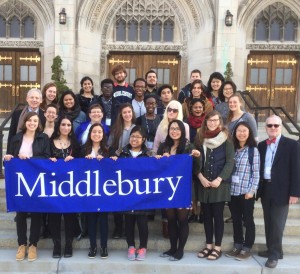Submitted by Larry Yarbrough
Wednesday was another full day, beginning with a tour of the Rebuild Foundation’s work in the South Shore/Grand Crossing section of the city, followed by a second afternoon of work at the Greater Chicago Food Depository, and ending with a reception hosted by Middlebury alumni/ae in Chicago.
The Rebuild Foundation is a creation of Theaster Gates, a Chicago native who is now a professor in the Department of Visual Art and Director of the Arts and Public Life initiative at the University of Chicago. Gates’ academic background in urban planning, fine arts, and religious studies resonates with many of the themes of our ASB trip to Chicago. The Foundation’s mission is “to rebuild the cultural foundations of underinvested neighborhoods and incite movements of community revitalization that are culture based, artist led, and neighborhood driven.”
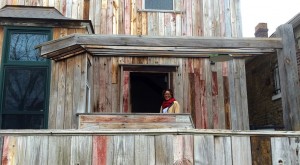 Begun in 2005, Gates’ vision began with the development of the Black Cinema House in derelict housing in the South Shore neighborhood and now includes the Stony Island Arts Bank, the Archive House, the Listening House, and most ambitiously the Dorchester Art + Housing Collaborative—which brought back into use an abandoned housing project that is now fully occupied with low-income and market-value apartments, performance spaces, and resident artist living and working space. See more on these and other projects at https://rebuild-foundation.org.
Begun in 2005, Gates’ vision began with the development of the Black Cinema House in derelict housing in the South Shore neighborhood and now includes the Stony Island Arts Bank, the Archive House, the Listening House, and most ambitiously the Dorchester Art + Housing Collaborative—which brought back into use an abandoned housing project that is now fully occupied with low-income and market-value apartments, performance spaces, and resident artist living and working space. See more on these and other projects at https://rebuild-foundation.org.
Sierra Jackson ’18 (Film and Media Studies and Black Student Union co-president) brought the South Shore/Grand Crossing project to our attention, having served as a volunteer with it in high school. Here is what she says about it:
Traveling to my neighborhood, South Shore/Grand Crossing, yesterday with the group was one of the most comforting experiences I have had throughout this entire trip. Sharing the history of my neighborhood and exploring the Rebuild Foundation allowed the group to learn about a piece of me. In that moment, I was able to share myself and watch students, staff, and faculty be open and receptive to this project. I believe an experience like this is invaluable – it is something I could never fully articulate solely on campus at Middlebury. I am extremely happy I was able to share this experience with those on this trip because it has now strengthened our relationship so much so that I consider them all family!
Louise Guibal-Engler, who is taking time away from her graduate studies in France to study at Middlebury this year, writes about our second day at the Greater Chicago Food Depository:
Today, we volunteered for a second time at the Greater Chicago Food Depository. No bread this afternoon. Instead, rice! Our goal was to repackage bulk rice into 3 pounds bags that can be distributed to people in need. One group of volunteers filled small plastic bags with rice; another group weighed them, adjusted the weight to 3 pounds, and sealed the bags. These bags were finally packed to boxes by a last group. In just under three hours, we packed over 7000 pounds of rice into 2640 bags!
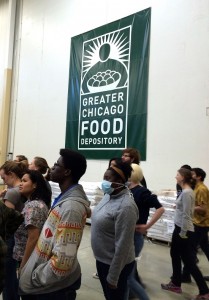 The Greater Chicago Food Depository has a motto:
The Greater Chicago Food Depository has a motto:
“We have 1 goal,
1 mission.
To fight hunger,
1 dollar,
1 meal,
1 person at a time.
Until the day
no 1 goes hungry.”
Every day except Sunday, the Greater Chicago Food Depository hosts volunteer work groups. Our few hours of volunteering in the depository helps many people who do not have access to good food or, in some instances, to any food. This experience inspires most of us to find ways to continue the work at home, whether Vermont or another country. Can we really stay inactive when people next door are starving? When we realize that in the US a third of the food is wasted, when there are people who do not have enough food—can we remain passive? Considering the whole world, in a country such as Burkina Faso (which has 17 millions people), 44.5% of the population is living under the poverty line and 88% of children under 5 as well as 49% of all women suffer from anemia—how can we let a third of the food—sixty billion kilos each year—go to waste while millions of people are starving, in the US and around the world?
Paola Meza ’19 reflects on the reception hosted by Chicago alumni/ae:
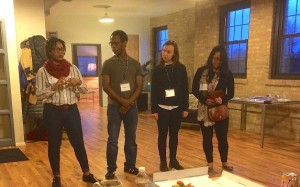 The middle of this incredible week was marked by an evening of reflection, relaxation, and delicious pizza, pasta, and salad.
The middle of this incredible week was marked by an evening of reflection, relaxation, and delicious pizza, pasta, and salad.
Thanks to Margie ’88 and John Devine ’87 (and P’ 18), we were able to connect with a small but distinguished group of Middlebury alumni/ae and parents residing in Chicago.
Sierra Jackson, an integral student organizer of the trip, beautifully articulated her motivation for bringing Middlebury to the realities of Chicago, her hometown. She, along with Anna Iglitzen ’17.5, Amari Simpson ’16, and Lin Georgia Wei summarized the itinerary for the first half of the week, emphasizing a wide array of topics including: the fusion of religion and politics, the standards of education, the influence of radio talk shows, the awareness of youth in underserved neighborhoods, and the impact of food banks on local communities.
Echoed by Father Pfleger from St. Sabina, WVON host Dorothy Wright Tillman, students and administrators of Butler College prep, and representatives of The Greater Chicago Food Depository, the recurring theme of these first couple of days was the importance of involvement in social activism as a lifelong pursuit, not just a short-lived phase during college years.
We hope to bring these very real experiences back to Vermont with the goal of recreating this type of honest and organic conversation around pressing issues on campus such as inclusivity and diversity. Initial efforts will take place on the Wednesday after we return (April 6) as students and faculty engage in round-table debriefing discussion at Wilson Hall.
The night ended on a celebratory note as the group sang Happy Birthday to Sierra and shared a cupcake and a slice of cake with her and her wonderful family.
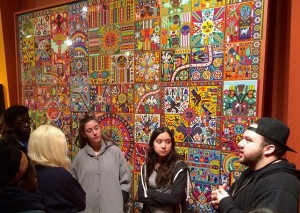 Our day started with a visit to the National Museum of Mexican Art in the Pilsen neighborhood of the city, which showcased Mexican art that challenges viewers to think about identity, cultural history, legends, revolutions, and more. The role of art has done so much to sustain culture for Mexican Americans faced with the everyday challenges of living in the US, so that many of us left thinking about how identities operate in promoting resistance against (or the acceptance of) dominant culture.
Our day started with a visit to the National Museum of Mexican Art in the Pilsen neighborhood of the city, which showcased Mexican art that challenges viewers to think about identity, cultural history, legends, revolutions, and more. The role of art has done so much to sustain culture for Mexican Americans faced with the everyday challenges of living in the US, so that many of us left thinking about how identities operate in promoting resistance against (or the acceptance of) dominant culture.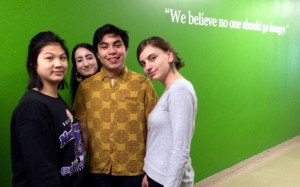 neighborhood to the Greater Chicago Food Depository on the city’s West Side. The work of the Food Depository, in general, serves to provide sustenance to those in Cook County who may not be able to provide for themselves or loved ones. Site workers shared that 1 in 5 people in the region go hungry, coming from all walks of life: the young, old, veterans, college students, and others. However, our volunteer work was unique on this particular day because we packaged materials in preparation for students who may not receive meals on the day that Chicago Teachers Union strikes, April 1st. Our role was to package bread and pop tarts for the three hours we volunteered for the day. Because our no. 1 goal was to have fun, most of us felt rewarded during the time we spent there and rewarded by the chance to help in anyway we could. With the combined efforts of all of the people volunteering that day, we prepared over 11,000 meals to be distributed to students on Friday when there would be no school.
neighborhood to the Greater Chicago Food Depository on the city’s West Side. The work of the Food Depository, in general, serves to provide sustenance to those in Cook County who may not be able to provide for themselves or loved ones. Site workers shared that 1 in 5 people in the region go hungry, coming from all walks of life: the young, old, veterans, college students, and others. However, our volunteer work was unique on this particular day because we packaged materials in preparation for students who may not receive meals on the day that Chicago Teachers Union strikes, April 1st. Our role was to package bread and pop tarts for the three hours we volunteered for the day. Because our no. 1 goal was to have fun, most of us felt rewarded during the time we spent there and rewarded by the chance to help in anyway we could. With the combined efforts of all of the people volunteering that day, we prepared over 11,000 meals to be distributed to students on Friday when there would be no school.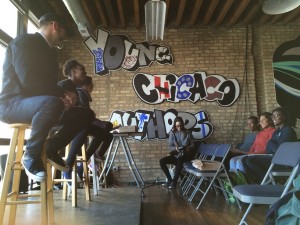 Finally, our day concluded with a trip to the Young Chicago Authors location in the Wicker Park neighborhood. We learned that young adults from all over the Chicagoland come to the Wicker Park location to perform and share their art—the same individuals who are very much connected to the activism that occurs in Chicago. Whether it’s dancing, singing, rapping, verging, or any other form of art, Young Chicago Authors provides a family-like atmosphere for everyone there. For this event, we started off by critically evaluating some poems and lyrics. Then we created our own work-shopped poems based, which were based on general theme related to labeling and social identity. Many people in the crowd shared their own work-shopped pieces, including Rabbi Schiffer. Afterwards during open-mic, various people from the audience shared their deeply personal and beautiful pieces related to faith, religion, family, the American Dream, queerness, sexual violence, their own identity, shootings in Chicago, and more. (Nia Robinson ’19 read a poem about her life as a person of color at Middlebury.) This event unapologetically revealed all facets of human life. The work that these young adults are doing is inspirational and invigorating for anyone interested in continued social justice and change.
Finally, our day concluded with a trip to the Young Chicago Authors location in the Wicker Park neighborhood. We learned that young adults from all over the Chicagoland come to the Wicker Park location to perform and share their art—the same individuals who are very much connected to the activism that occurs in Chicago. Whether it’s dancing, singing, rapping, verging, or any other form of art, Young Chicago Authors provides a family-like atmosphere for everyone there. For this event, we started off by critically evaluating some poems and lyrics. Then we created our own work-shopped poems based, which were based on general theme related to labeling and social identity. Many people in the crowd shared their own work-shopped pieces, including Rabbi Schiffer. Afterwards during open-mic, various people from the audience shared their deeply personal and beautiful pieces related to faith, religion, family, the American Dream, queerness, sexual violence, their own identity, shootings in Chicago, and more. (Nia Robinson ’19 read a poem about her life as a person of color at Middlebury.) This event unapologetically revealed all facets of human life. The work that these young adults are doing is inspirational and invigorating for anyone interested in continued social justice and change.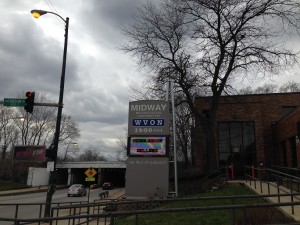 (submitted by Larry Yarbrough)
(submitted by Larry Yarbrough)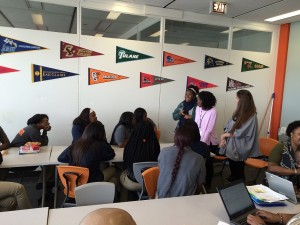 After touring the facilities with two juniors, we met in small groups with 80 Butler students who are beginning to think and plan for the next steps in their education. Our six Chicago students divided themselves among the groups, joined by other Middlebury students to talk about transition to college and college life. It was not all pitching a line. The conversations dealt with real challenges students from schools like Butler face when attending elite colleges like Middlebury. Butler students had tough questions; our students were impressed—and a little unsettled.
After touring the facilities with two juniors, we met in small groups with 80 Butler students who are beginning to think and plan for the next steps in their education. Our six Chicago students divided themselves among the groups, joined by other Middlebury students to talk about transition to college and college life. It was not all pitching a line. The conversations dealt with real challenges students from schools like Butler face when attending elite colleges like Middlebury. Butler students had tough questions; our students were impressed—and a little unsettled.